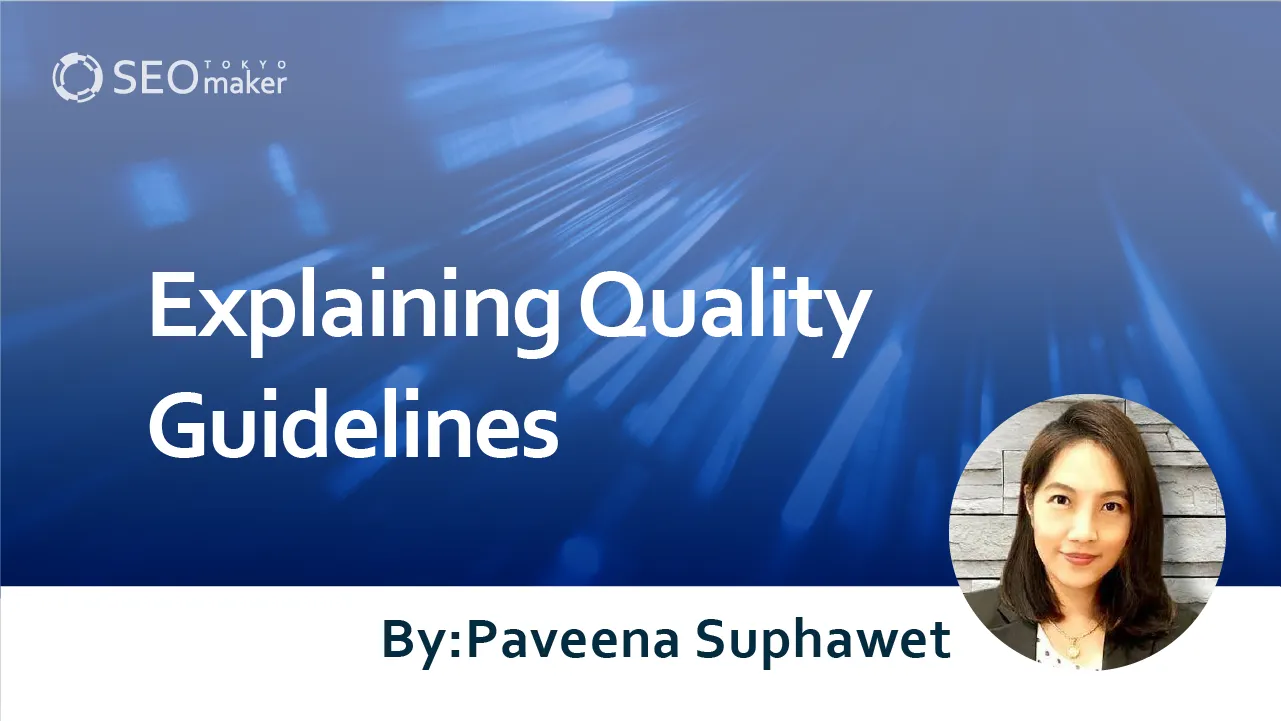Explaining Quality Guidelines ~For Advanced SEO Strategies~
contents
- 1 Automated Content Creation
- 2 Improper Redirects
- 3 Link Schemes
- 4 Low-Quality Content
- 5 Paid Links
- 6 Cloaking
- 7 Hidden Text and Hidden Links
- 8 Doorway Pages
- 9 Unauthorized Content Replication
- 10 Affiliate Programs
- 11 Keyword Stuffing
- 12 Creation of Malicious Pages
- 13 User-Generated Spam
- 14 Methods to Prevent Comment Spam
- 15 Summary

Here, we’ll delve into item 3: Quality Guidelines. If you’re new to SEO, please also check out the 2022 Complete Guide to SEO which explains everything from the basics to strategies for achieving higher rankings for beginners.
The Advanced SEO Strategy Guidelines consist of the following six contents. Please find the articles that are necessary for you.
Advanced SEO Strategy Guidelines
- Content-Related Guidelines for Advanced SEO
- Quality Guidelines for Advanced SEO
- Control of Crawling and Indexing for Advanced SEO
- Advanced Hacks for SERPs
- Page Experience Optimization for Advanced SEO
Automated Content Creation
It’s well known that content becomes more valuable when written or supervised by someone knowledgeable about the industry. Sometimes we may research industry information and have writers compose the content, but in any case, it’s essential that it’s written by humans.
While generating text is possible without human intervention, automatically created content by computers often tends to be difficult to read or the intentions behind it can become unclear, making it not recommendable.
Especially avoid engaging in the following types of automatically generated content, as they may not be valued or could receive negative feedback
- Text that contains SEO keywords but makes no meaningful sense
- Automatically translated text without human editing
- Content generated through automated processes
- Text created by automating synonyms or using complex words unnecessarily
- Unauthorized copies of text from Atom/RSS feeds or search results
- Combining multiple existing contents without adding any value
Improper Redirects
Redirects are commonly used for consolidating pages or during site renovations, and if handled correctly, they can preserve and transfer page value, benefiting SEO.
However, the following types of improper redirects may result in negative impacts.
- Redirecting users and crawlers to different URLs
- Sending PC users and mobile users to different URLs
Particularly, techniques that guide users and crawlers to different URLs fall under cloaking and must be avoided. Even in A/B testing, incorrect settings could lead to penalties, so be cautious.
Link Schemes
Placing links with the intent to manipulate page rank or search rankings can violate guidelines and be subject to penalties.
Please note the section on ‘intent to manipulate PageRank or search result rankings.’ Many people misunderstand this, but using paid links or unnatural links does not violate our guidelines if the intent is not to manipulate rankings.
The following actions are examples of what to avoid.
- Buying or selling links that pass page rank (paid links)
- Excessive link exchanges
- Pages created solely for cross-linking
- Large-scale article marketing campaigns
- Using automated programs to gather links
- Mandating third parties to link back for the purpose of transferring page rank
*Please note that prohibited article marketing refers to paying for links posted on pages. Article marketing itself, which simply states that ‘our site is link-free and you may quote it with proper attribution,’ is acceptable. However, if the intent is to transfer PageRank, it could lead to penalties.
Low-Quality Content
Google prioritizes content quality. Low-quality content is unlikely to rank well, and articles that are unauthorized copies or lack originality might face penalties.
Especially avoid the following, as they are violations of Google’s guidelines
- Automatically generated content
- Thin affiliate pages
- Unauthorized copied content
- Misleading pages
Paid Links
While there are overlaps with link schemes, Google does not inherently oppose paid links. However, paid links intended to manipulate rankings are subject to penalties.
Examples of acceptable paid links include advertisements. When deploying ads, please ensure that the links are clearly marked as advertising by using one of the following methods.
- Add a rel=”nofollow” or rel=”sponsored” attribute to the <a> tag
- Use robots.txt to redirect links to pages that are blocked from search engines
Cloaking
Cloaking involves showing different URLs or content to users and search engines. Naturally, it violates guidelines and is subject to penalties.
Cloaking can include
- Displaying a text page to search engines while showing a page with images or Flash to users, which might be more understandable for users but not for search engines.
- Inserting text or keywords into a page only when the page request comes from a search engine.
Using techniques that are hard for search engines to access but are beneficial for users is not cloaking if you ensure that both crawlers and users see the same content.
Hidden Text and Hidden Links
Hidden text and links involve showing content to crawlers that is not visible to users, essentially presenting different content to crawlers and users. Both are subject to penalties.
Examples of hidden text and links are as follows.
- Using text the same color as the background
- Placing text behind an image
- Positioning text off-screen with CSS
- Setting the font size to zero
- Using a tiny single character as a link to make it difficult to recognize as a link
Doorway Pages
Doorway pages are created with the goal of ranking high for specific keywords. These pages ultimately guide users to another site with similar content, making them less valuable for users and a violation of guidelines.
Examples of doorway pages are as follows.
- Having multiple pages for specific regions or cities that guide users to a particular page
- Pages designed to guide users to useful or relevant content within the site
- Multiple pages within a site that have similar content
In SEO, the number of pages a site has is important, but filling those pages with unauthorized copied content is against the guidelines. Even if not outright copied, content that overly relies on references without adding value often goes unrecognized, necessitating the creation of original content.
The following are all considered unauthorized copying by Google.
- Sites that copy content from other sites and repost it without adding any original content or value.
- Sites that make minor edits to copied content (such as changing words to synonyms or using automated methods) before reposting.
- Sites that post content feeds from other sites without any original structuring or added convenience for the user.
- Sites that embed content from other sites, such as videos, images, or other media, without providing substantial added value to the user. As you can see, content that is simply copied from another site or slightly modified is recognized as unauthorized replication.
Just to clarify, content that is directly copied from another site, or even content that is slightly modified from another site’s material, is considered unauthorized reproduction.
Ensuring that your site contains unique information will prevent it from being deemed as containing unauthorized copies and will also guarantee the quality of your articles.
Affiliate Programs
Affiliate sites often describe specific products and may end up resembling or lacking originality compared to content on other sites. Without sufficient added value, such content often ranks poorly, posing a barrier to successful affiliate marketing.
When engaging in affiliate marketing, mere product descriptions or reviews are not enough on a page-by-page basis, and sites made up solely of affiliate pages often lack sufficient original content, making SEO-driven traffic acquisition challenging.
To deliver high-quality content in affiliate marketing, consider the following.
- Ensure affiliate content only makes up a small part of your site.
- Create content that provides substantial value beyond what the vendor offers.
- Choose affiliate programs that align with your site’s theme.
- Engage in user communities and provide unique content through discussions, forums, and reviews.
- Continuously create up-to-date and relevant content.
Keyword Stuffing
Manipulating rankings by stuffing contextually irrelevant keywords or numbers into content is a violation of guidelines. Repeating meaningless keywords or listing information can decrease your rankings, so avoid this practice.
Especially, inserting city names, product names, or phone numbers without relevance into text can decrease usability and yield poor results.
Creation of Malicious Pages
Providing content that performs actions not expected by users is against guidelines. Despite this, many pages with malicious intent exist, compromising user safety. Google strongly regulates pages with malicious behaviors, so absolutely avoid the following tactics in legitimate marketing efforts.
- Making it appear as if a user has clicked on a button they did not intend to.
- Replacing ads on a page with different ones.
- Including unintended downloads with the intended downloads.
- Attempting to install malware, spyware, or viruses.
- Changing browser settings without user consent.
User-Generated Spam
While site management is typically restricted to administrators, some services allow users to add content, with platforms like Wikipedia being prime examples. Even common blogs often receive user comments.
However, these can be exploited for spam activities. While user-generated spam generally affects only individual pages rather than the whole site, severe cases can negatively impact the entire site.
Examples of user-generated spam are as follows.
- Spam accounts using free hosts.
- Spam posts in forums.
- Spam comments on blogs.
Methods to Prevent Comment Spam
Comment spam can negatively impact your website. Here are some of the potential negative effects.
- Low-quality content in parts of your site can harm the overall ranking.
- Spam that makes users uncomfortable can lower your site’s reputation.
- Unrelated content-driven traffic can slow down your site and increase bandwidth costs.
- Pages with a lot of user-generated spam might be removed by Google or have their rankings lowered to protect the quality of search results.
- Spammers can redirect your users to malicious sites. Therefore, protecting your website from malicious spam is crucial.
It’s beneficial to try several spam prevention methods simultaneously.
Google’s reCAPTCHA Service
Google’s reCAPTCHA service is free and easy to implement on your site. For WordPress users, reCAPTCHA plugins are available. This not only protects your site from spammers but also contributes to the digitization of books worldwide.
Add ‘noindex robots’ Meta Tags to Posts from New Users
Spam comments often include the poster’s URL to redirect users. By adding a noindex robots meta tag to posts from new, unvetted users, you can effectively block spam contributions to your community.
Monitor Your Site with Google Alerts
Set up Google Alerts using undesirable keywords with the “site:” query to monitor your site. Google Alerts can also help detect pages that have been hacked.
Summary
Until around 2017, it was common to see pages rank high despite poor content quality if there were many pages. However, since 2018, the demand for content quality has been increasing yearly.
Defining high quality can be challenging, but Google provides examples of what poor quality entails, so avoid the practices discussed here.
Producing large amounts of low-quality content or embedding excessive keywords to artificially boost rankings might still work in 2021, but these are not sustainable long-term strategies. Such techniques are also difficult to convert, making them highly inadvisable. Ultimately, facing the user is the final measure for search engine optimization. However, engaging with users can be challenging. If you find it difficult, consider consulting with Tokyo SEO Maker.










![What is a Description? Explaining the Meaning, Writing Style, and Changing Word Count – [2023 Edition]](https://www.switchitmaker2.com/en/wp-content/uploads/2024/09/what-is-description.webp)










